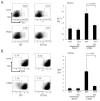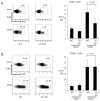Toll-like receptor 7 controls the anti-retroviral germinal center response
- PMID: 21998589
- PMCID: PMC3188541
- DOI: 10.1371/journal.ppat.1002293
Toll-like receptor 7 controls the anti-retroviral germinal center response
Abstract
The development of vaccines that can enhance immunity to viral pathogens is an important goal. However, the innate molecular pathways that regulate the strength and quality of the immune response remain largely uncharacterized. To define the role of Toll-like receptor (TLR) signaling in control of a model retroviral pathogen, Friend virus (FV), I generated mice in which the TLR signaling adapter Myd88 was selectively deleted in dendritic cell (DC) or in B cell lineages. Deletion of Myd88 in DCs had little effect on immune control of FV, while B cell specific deletion of Myd88 caused a dramatic increase in viral infectious centers and a significantly reduced antibody response, indicating that B cell-intrinsic TLR signaling plays a crucial role, while TLR signaling in DCs is less important. I then identified the single-stranded RNA sensing protein TLR7 as being required for antibody-mediated control of FV by analyzing mice deficient in TLR7. Remarkably, B cells in infected TLR7-deficient mice upregulated CD69 and CD86 early in infection, but failed to develop into germinal center B cells. CD4 T cell responses were also attenuated in the absence of TLR7, but CD8 responses were TLR7 independent, suggesting the existence of additional pathways for detection of retroviral particles. Together these results demonstrate that the vertebrate immune system detects retroviruses in vivo via TLR7 and that this pathway regulates a key checkpoint controlling development of germinal center B cells.
Conflict of interest statement
The author has declared that no competing interests exist.
Figures










Similar articles
-
Myd88 is required for an antibody response to retroviral infection.PLoS Pathog. 2009 Feb;5(2):e1000298. doi: 10.1371/journal.ppat.1000298. Epub 2009 Feb 13. PLoS Pathog. 2009. PMID: 19214214 Free PMC article.
-
Toll-like receptor 7 inhibits early acute retroviral infection through rapid lymphocyte responses.J Virol. 2013 Jul;87(13):7357-66. doi: 10.1128/JVI.00788-13. Epub 2013 Apr 24. J Virol. 2013. PMID: 23616654 Free PMC article.
-
A West Nile virus NS4B-P38G mutant strain induces adaptive immunity via TLR7-MyD88-dependent and independent signaling pathways.Vaccine. 2013 Aug 28;31(38):4143-51. doi: 10.1016/j.vaccine.2013.06.093. Epub 2013 Jul 8. Vaccine. 2013. PMID: 23845800 Free PMC article.
-
Contribution of Toll-like receptor signaling to germinal center antibody responses.Immunol Rev. 2012 May;247(1):64-72. doi: 10.1111/j.1600-065X.2012.01115.x. Immunol Rev. 2012. PMID: 22500832 Free PMC article. Review.
-
B-Cell Control of Regulatory T Cells in Friend Virus Infection.J Mol Biol. 2021 Jan 8;433(1):166583. doi: 10.1016/j.jmb.2020.06.022. Epub 2020 Jun 26. J Mol Biol. 2021. PMID: 32598936 Review.
Cited by
-
Toll-Like Receptor 7 Enhances Rabies Virus-Induced Humoral Immunity by Facilitating the Formation of Germinal Centers.Front Immunol. 2019 Mar 8;10:429. doi: 10.3389/fimmu.2019.00429. eCollection 2019. Front Immunol. 2019. PMID: 30906301 Free PMC article.
-
Human Endogenous Retroviruses (HERVs): Shaping the Innate Immune Response in Cancers.Cancers (Basel). 2020 Mar 6;12(3):610. doi: 10.3390/cancers12030610. Cancers (Basel). 2020. PMID: 32155827 Free PMC article. Review.
-
Female predisposition to TLR7-driven autoimmunity: gene dosage and the escape from X chromosome inactivation.Semin Immunopathol. 2019 Mar;41(2):153-164. doi: 10.1007/s00281-018-0712-y. Epub 2018 Oct 1. Semin Immunopathol. 2019. PMID: 30276444 Review.
-
A Single Locus Controls Interferon Gamma-Independent Antiretroviral Neutralizing Antibody Responses.J Virol. 2018 Jul 31;92(16):e00725-18. doi: 10.1128/JVI.00725-18. Print 2018 Aug 15. J Virol. 2018. PMID: 29875252 Free PMC article.
-
Control of adaptive immunity by pattern recognition receptors.Immunity. 2024 Apr 9;57(4):632-648. doi: 10.1016/j.immuni.2024.03.014. Immunity. 2024. PMID: 38599163 Free PMC article. Review.
References
-
- Broder S, Gallo RC. A pathogenic retrovirus (HTLV-III) linked to AIDS. N Engl J Med. 1984;311:1292–1297. - PubMed
-
- Barre-Sinoussi F, Chermann JC, Rey F, Nugeyre MT, Chamaret S, et al. Isolation of a T-lymphotropic retrovirus from a patient at risk for acquired immune deficiency syndrome (AIDS). Science. 1983;220:868–871. - PubMed
-
- Kwong PD, Doyle ML, Casper DJ, Cicala C, Leavitt SA, et al. HIV-1 evades antibody-mediated neutralization through conformational masking of receptor-binding sites. Nature. 2002;420:678–682. - PubMed
Publication types
MeSH terms
Substances
LinkOut - more resources
Full Text Sources
Other Literature Sources
Molecular Biology Databases
Research Materials

